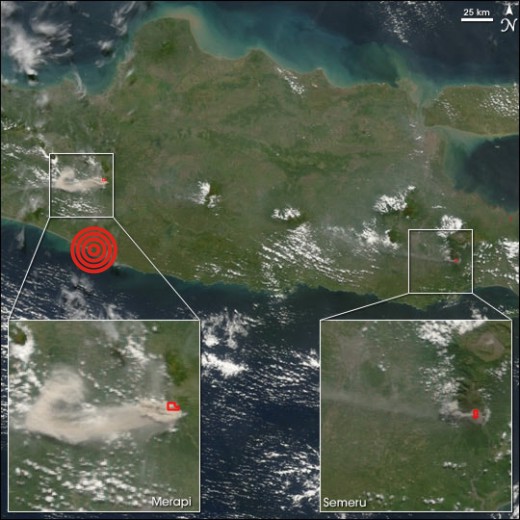Given my previous post on seismic triggering of volcanic eruptions, this is quite interesting:
The intensity of two ongoing volcanic eruptions on Indonesia’s Java Island increased sharply three days following a powerful, 6.4-magnitude earthquake on the island in May 2006. The increased volcanic activity persisted for about nine days.

When Indonesia was struck by the earthquake in question on May 26th last year – – I’ve added its approximate location to the picture above* – the two volcanoes in question were already erupting: Merapi kicked off last April and Semeru has apparently been erupting fairly continuously since 1967.
This meant that they were being monitored closely by Andrew Harris and his colleagues at the University of Hawaii. They have pretty cool system set up, which uses geostationary satellites to automatically detect and monitor ‘hotspots’ – temperature anomalies due to volcanic activity or forest fires – in near real time (go here for the latest observations).
This capability was put to good use to provide daily measurements of the vent temperature and lava output of these two volcanoes in the period immediately following the earthquake. According to the abstract of their GRL Paper, the latter increased by 2–3 times over a nine day period starting 3 days after the eruption, before volcanic activity subsided back to pre-earthquake levels.
The two interesting things about this response are the time delay, and the fact that it superficially appears to have been pretty much the same at both volcanoes despite them being quite different distances from the earthquake epicentre. The former is probably because the seismic waves would have had their greatest effect in the magma chamber rather than the vent, so this reflects the time it took for the invigorated magma to get from the chamber to the surface. It’s hard to say what the latter means; but it looks like semi-automated satellite observations like this can potentially provide a lot of detailed data about the interactions between earthquakes and volcanoes in the next few years, so hopefully it will become clearer with time.



Comments (1)